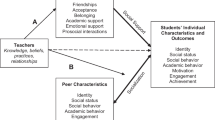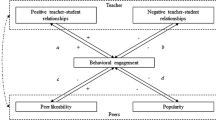Abstract
Secondary school is a vulnerable time where stagnation or declines in classroom behavioral engagement occur for many students, and peer relationships take on a heightened significance. We examined the implications of adolescents’ perceptions of relatedness with classroom peers for their academic learning. Participants were 1084 adolescents (53% female) in 65 middle and high school classrooms. Multilevel cross-lagged path analyses found that adolescents’ perceived relatedness with classroom peers subsequently predicted their increased self-reported behavioral engagement in that classroom from fall to winter and again from winter to spring. Higher engagement in spring predicted higher end of year objective achievement test scores after statistical control of prior year test scores. Implications are discussed for increasing classroom peer relatedness to enhance adolescents’ achievement.

Similar content being viewed by others
References
Allen, J. P., Pianta, R. C., Gregory, A., Mikami, A. Y., & Lun, J. (2011). An interaction-based approach to enhancing secondary school instruction and student achievement. Science, 333(6045), 1034–1037. doi:10.1126/science.1207998.
Baumeister, R. F., Twenge, J. M., & Nuss, C. K. (2002). Effects of social exclusion on cognitive processes: Anticipated aloneness reduces intelligent thought. Journal of Personality and Social Psychology, 83(4), 817–827. doi:10.1037/0022-3514.83.4.817.
Buelow, M. T., Okdie, B. M., Brunell, A. B., & Trost, Z. (2015). Stuck in a moment and you cannot get out of it: The lingering effects of ostracism on cognition and satisfaction of basic needs. Personality and Individual Differences, 76, 39–43. doi:10.1016/j.paid.2014.11.051.
Cacioppo, J. T., & Patrick, W. (2008). Loneliness: Human nature and the need for social connection. New York, NY: WW Norton & Company.
Chen, X., Rubin, K. H., & Li, D. (1997). Relation between academic achievement and social adjustment: Evidence from Chinese children. Developmental psychology, 33(3), 518–525. doi:10.1037/0012-1649.33.3.518.
De Wit, D. J., Karioja, K., Rye, B. J., & Shain, M. (2011). Perceptions of declining classmate and teacher support following the transition to high school: Potential correlates of increasing student mental health difficulties. Psychology in the Schools, 48(6), 556–572. doi:10.1002/pits.20576.
Dishion, T. J., & Tipsord, J. M. (2011). Peer contagion in child and adolescent social and emotional development. Annual Review of Psychology, 62, 189–214. doi:10.1146/annurev.psych.093008.100412.
Farmer, T. W., Lines, M. M., & Hamm, J. V. (2011). Revealing the invisible hand: The role of teachers in children’s peer experiences. Journal of Applied Developmental Psychology, 32(5), 247–256. doi:10.1016/j.appdev.2011.04.006.
Flook, L., Repetti, R. L., & Ullman, J. B. (2005). Classroom social experiences as predictors of academic performance. Developmental Psychology, 41(2), 319.
Goodenow, C. (1993). Classroom belonging among early adolescent students relationships to motivation and achievement. The Journal of Early Adolescence, 13(1), 21–43.
Hamm, J. V., & Faircloth, B. S. (2005). Peer context of mathematics classroom belonging in early adolescence. The Journal of Early Adolescence, 25(3), 345–366. doi:10.1177/0272431605276932.
Hamm, J. V., Farmer, T. W., Dadisman, K., Gravelle, M., & Murray, A. R. (2011). Teachers’ attunement to students’ peer group affiliations as a source of improved student experiences of the school social–affective context following the middle school transition. Journal of Applied Developmental Psychology, 32(5), 267–277. doi:10.1016/j.appdev.2010.06.003.
Hamm, J. V., Farmer, T. W., Lambert, K., & Gravelle, M. (2014). Enhancing peer cultures of academic effort and achievement in early adolescence: Promotive effects of the SEALS intervention. Developmental psychology, 50(1), 216.
Harter, S. (1985). Manual for the self-perception profile for children. Denver, CO: University of Denver.
Hoglund, W. L. (2007). School functioning in early adolescence: Gender-linked responses to peer victimization. Journal of Educational Psychology, 99(4), 683.
Iyer, R. V., Kochenderfer-Ladd, B., Eisenberg, N., & Thompson, M. (2010). Peer victimization and effortful control: Relations to school engagement and academic achievement. Merrill-Palmer Quarterly, 56(3), 361–387. doi:10.1353/mpq.0.0058.
Jeynes, W. H. (2007). The relationship between parental involvement and urban secondary school student academic achievement: A meta-analysis. Urban Education, 42(1), 82–110.
Jussim, L., & Eccles, J. S. (1992). Teacher expectations: II. Construction and reflection of student achievement. Journal of Personality and Social Psychology, 63(6), 947–961. doi:10.1037/0022-3514.63.6.947.
Juvonen, J. (2007). Reforming middle schools: Focus on continuity, social connectedness, and engagement. Educational Psychologist, 42(4), 197–208. doi:10.1080/00461520701621046.
Kindermann, T. A. (2011). Commentary: The invisible hand of the teacher. Journal of Applied Developmental Psychology, 32(5), 304–308. doi:10.1016/j.appdev.2011.04.005.
Kingery, J. N., Erdley, C. A., & Marshall, K. C. (2011). Peer acceptance and friendship as predictors of early adolescents’ adjustment across the middle school transition. Merrill-Palmer Quarterly, 57(3), 215–243.
Ladd, G. W., Birch, S. H., & Buhs, E. S. (1999). Children’s social and scholastic lives in kindergarten: Related spheres of influence? Child Development, 70(6), 1373–1400. doi:10.1111/1467-8624.00101.
Ladd, G. W., Herald-Brown, S. L., & Reiser, M. (2008). Does chronic classroom peer rejection predict the development of children’s classroom participation during the grade school years? Child Development, 79(4), 1001–1015. doi:10.1111/j.1467-8624.2008.01172.x.
Lee, J.-S. (2014). The relationship between student engagement and academic performance: Is it a myth or reality? The Journal of Educational Research, 107(3), 177–185. doi:10.1080/00220671.2013.807491.
Liem, G. A. D., & Martin, A. J. (2011). Peer relationships and adolescents’ academic and non-academic outcomes: Same-sex and opposite-sex peer effects and the mediating role of school engagement. British Journal of Educational Psychology, 81(2), 183–206. doi:10.1111/j.2044-8279.2010.02013.x.
Little, T. D. (2013). Longitudinal structural equation modeling. New York, NY: The Guilford Press.
McElhaney, K. B., Antonishak, J., & Allen, J. P. (2008). “They like me, they like me not”: Popularity and adolescents’ perceptions of acceptance predicting social functioning over time. Child Development, 79(3), 720–731. doi:10.1111/j.1467-8624.2008.01153.x.
McMaster, K. L., Fuchs, D., & Fuchs, L. S. (2006). Research on peer-assisted learning strategies: The promise and limitations of peer-mediated instruction. Reading and Writing Quarterly, 22(1), 5–25. doi:10.1080/10573560500203491.
Mikami, A. Y., Boucher, M. A., & Humphreys, K. (2005). Prevention of peer rejection through a classroom-level intervention in middle school. The Journal of Primary Prevention, 26(1), 5–23. doi:10.1007/s10935-004-0988-7.
Mikami, A. Y., Gregory, A., Allen, J. P., Pianta, R. C., & Lun, J. (2011). Effects of a teacher professional development intervention on peer relationships in secondary classrooms. School Psychology Review, 40(3), 367–385.
Mikami, A. Y., Lerner, M. D., & Lun, J. (2010). Social context influences on children’s rejection by their peers. Child Development Perspectives, 4(2), 123–130. doi:10.1111/j.1750-8606.2010.00130.x.
Muthén, L. K., & Muthén, B. O. (2014). Mplus User’s Guide. 7th edn. Los Angeles: Muthén & Muthén.
Rambaran, J. A., Hopmeyer, A., Schwartz, D., Steglich, C., Badaly, D., & Veenstra, R. (2017). Academic functioning and peer influences: A short-term longitudinal study of network–behavior dynamics in middle adolescence. Child Development, 88(2), 523–543. doi:10.1111/cdev.12611.
Rodkin, P. C., & Ryan, A. M. (2012). Child and adolescent peer relations in educational context. In K. R. Harris, S. Graham, T. Urdan, S. Graham, J. M. Royer & M. Zeidner (Eds.), APA educational psychology handbook, Vol 2: Individual differences and cultural and contextual factors (pp. 363–389). Washington, DC, US: American Psychological Association.
Ruzek, E. A., Hafen, C. A., Allen, J. P., Gregory, A., Mikami, A. Y., & Pianta, R. C. (2016). How teacher emotional support motivates students: The mediating roles of perceived peer relatedness, autonomy support, and competence. Learning and Instruction, 42, 95–103. doi:10.1016/j.learninstruc.2016.01.004.
Ryan, A. M. (2000). Peer groups as a context for the socialization of adolescents’ motivation, engagement, and achievement in school. Educational Psychologist, 35(2), 101–111. doi:10.1207/s15326985ep3502_4.
Ryan, A. M., Kuusinen, C. M., & Bedoya-Skoog, A. (2015). Managing peer relations: A dimension of teacher self-efficacy that varies between elementary and middle school teachers and is associated with observed classroom quality. Contemporary Educational Psychology, 41, 147–156. doi:10.1016/j.cedpsych.2015.01.002.
Ryan, A. M., & Patrick, H. (2001). The classroom social environment and changes in adolescents’ motivation and engagement during middle school. American Educational Research Journal, 38(2), 437–460.
Ryan, A. M., & Shim, S. S. (2012). Changes in help seeking from peers during early adolescence: Associations with changes in achievement and perceptions of teachers. Journal of Educational Psychology, 104(4), 1122–1134. doi:10.1037/a0027696.
Song, J., Bong, M., Lee, K., & Kim, S.-i (2015). Longitudinal investigation into the role of perceived social support in adolescents’ academic motivation and achievement. Journal of Educational Psychology, 107(3), 821–841. doi:10.1037/edu0000016.
Twenge, J. M., Catanese, K. R., & Baumeister, R. F. (2002). Social exclusion causes self-defeating behavior. Journal of Personality and Social Psychology, 83(3), 606–615. doi:10.1037/0022-3514.83.3.606.
Villegas-Reimers, E. (2003). Teacher professional development: an international review of the literature. Paris: International Institute for Educational Planning.
Virginia Department of Education. (2015). Virginia Standards of Learning (SOL) Assessments Technical Report, from http://www.doe.virginia.gov/testing/test_administration/technical_reports/sol_technical_report_2014-15_administration_cycle.pdf.
Walton, G. M., & Cohen, G. L. (2011). A brief social-belonging intervention improves academic and health outcomes of minority students. Science, 331(6023), 1447–1451.
Wang, M.-T., Chow, A., Hofkens, T., & Salmela-Aro, K. (2015). The trajectories of student emotional engagement and school burnout with academic and psychological development: Findings from Finnish adolescents. Learning and Instruction, 36, 57–65. doi:10.1016/j.learninstruc.2014.11.004.
Wellborn, J. G. (1991). Engaged and disaffected action: The conceptualization of engagement and motivation in the academic domain. New York,NY: University of Rochester.
Wentzel, K. R., Battle, A., Russell, S. L., & Looney, L. B. (2010). Social supports from teachers and peers as predictors of academic and social motivation. Contemporary Educational Psychology, 35(3), 193–202. doi:10.1016/j.cedpsych.2010.03.002.
Wentzel, K. R., Russell, S., & Baker, S. (2016). Emotional support and expectations from parents, teachers, and peers predict adolescent competence at school. Journal of Educational Psychology, 108(2), 242–255. doi:10.1037/edu0000049.
Wing, J. Y. (2006). Integration across campus, segregation across classrooms: A close-up look at privilege. In P. A. Noguera & J. Y. Wing (Eds.), Unfinished business: Closing the achievement gap in our schools (pp. 84–121). San Francisco: Wiley and Sons.
Acknowledgements
We would like to thank the students and teachers who participated in this study, as well as the many research assistants who assisted with the study and data collection procedures.
Author Contributions
A.Y.M. conceived of the study, participated in its design and coordination, and drafted the manuscript; E.A.R. participated in the design and coordination of the study, helped to draft the manuscript, and conducted the data analysis; C.A.H. participated in the design and coordination of the study and conducted the data analysis; A.G. participated in the design and coordination of the study; J.P.A. participated in the design and coordination of the study. All authors read and approved the final manuscript.
Funding
This research was supported by funding from the William T. Grant Foundation, from the Institute of Education Sciences R305A100367, and from the National Institutes of Health 9R01 HD058305-16A1 to Joseph P. Allen.
Author information
Authors and Affiliations
Corresponding author
Ethics declarations
Conflict of Interest
The authors declare that they have no competing interests.
Ethical Approval
Study procedures were approved by the Institutional Research Ethics Board at the University of Virginia, and by the school districts where the data were collected. All procedures performed were in accordance with the ethical standards of the institutional research committee and with the 1964 Helsinki declaration and its later amendments.
Informed Consent
Informed consent was obtained from all individual participants included in the study. For the participants who were minors, they provided informed assent while their parents provided informed consent.
Rights and permissions
About this article
Cite this article
Mikami, A.Y., Ruzek, E.A., Hafen, C.A. et al. Perceptions of Relatedness with Classroom Peers Promote Adolescents’ Behavioral Engagement and Achievement in Secondary School. J Youth Adolescence 46, 2341–2354 (2017). https://doi.org/10.1007/s10964-017-0724-2
Received:
Accepted:
Published:
Issue Date:
DOI: https://doi.org/10.1007/s10964-017-0724-2




